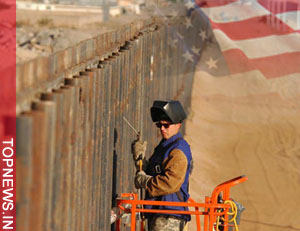US border fence has many loopholes, some them deadly
 FEATURE: US border fence has many loopholes, some them deadly By Franz Smets, dpa Eds: First of two stories on illegal immigration from Mexico into the United States, second in series to move early Saturday; epa photo 00000400854516 available =
FEATURE: US border fence has many loopholes, some them deadly By Franz Smets, dpa Eds: First of two stories on illegal immigration from Mexico into the United States, second in series to move early Saturday; epa photo 00000400854516 available =
Nogales, Mexico (dpa) - The United States has stepped up efforts over the last two years to contain the inflow of illegal immigrants across its southern border from Mexico and Central America.
Washington is fortifying its 3,000-kilometre border with Mexico, with a view to preventing people from reaching the United States, where an estimated 11 million so-called "indocumentados," or undocumented workers, already live.
An estimated 500,000 people every year cross the border without authorization to search for a better life in the United States, while another 1 million or so are caught and sent back.
Mexicans refer to the obstacle as "El Muro" - the wall - a reference to the Berlin Wall. What the United States is really building, though, is mostly a double fence that is by no means a hardened fortification.
The new fence stretches along some 1,000 kilometres of the border, particularly near the Mexican cities of Tijuana, Tecate, Mexicali, Nogales and Ciudad Juarez, as well as around all border crossings.
"In this stretch of border, Mexicans used to be able to cross to San Diego, Tucson and El Paso on foot, by car and even by bus, and no one stopped them," said Rodolfo Corona of Colegio de la Frontera Norte, a border research institution in Tijuana.
The old fence is riddled with holes where migrants have slipped through. Nowadays, however, this is increasingly difficult. In the hills west of Tijuana, whole valleys have been leveled to make the terrain easier to monitor for US border agents.
Parallel to the old fence, a new metal fence is taking shape on US territory. It is 4 metres high, and see-through: the US border officers patrolling between the two fences can see what is happening on either side beyond the fence.
White balloons hover high over the border, carrying surveillance equipment to spot movement, particularly the drug-smuggling aircraft zooming up from the south.
"We do not think that the wall contains migration," the Mexican Protection Consul Gustavo Morales Cirion, who is in charge of the welfare of Mexican immigrants, said in Douglas, Arizona, some 100 kilometres east of Nogales.
However, crossing the border has become a riskier and sometimes lethal endeavour. With other routes closed off by the fence, migrants have switched to more dangerous routes, for example, over the Rumorosa Mountainss east of Tijuana or through harsh deserts along the frontier in Arizona, California and Texas.
They walk for days before reaching the United States. After climbing the fence, some break legs jumping down onto the northern side. Those who make it over in one piece face further jeopardy as mundane as exposure and dehydration and as exotic as bites from venomous snakes.
"At night it is cold. During the daytime it is hot," Morales Cirion explained.
The border fence has many faces. Sometimes it is simple barbed wire, like that used to fence in cattle, sometimes metre-high railing with iron bars or chains, sometimes overlapping metal plates and metal pipes filled with cement.
Where there are no roads or paths, there is no fence, with terrain and climate presenting formidable barriers. Yet the risk of death fails to deter many potential immigrants from trekking north.
From Sonora, California, the fence stretches kilometres into the desert, running along Mexico's State Road 2, the only link from Baja California in Mexico to the border into California. Along this stretch, the fence is formed by metal plates, set in a concrete base sunk 200 centimetres into the ground.
Nature has already taken its toll. Windblown sand has carved openings into the wall, often spots where the US border patrol stands guard to apprehend anyone trying to sneak through.
All along the fence, large signs warn of the dangers ahead. Since 1994, an estimated 5,000 people have died trying to cross through the border region. (dpa)